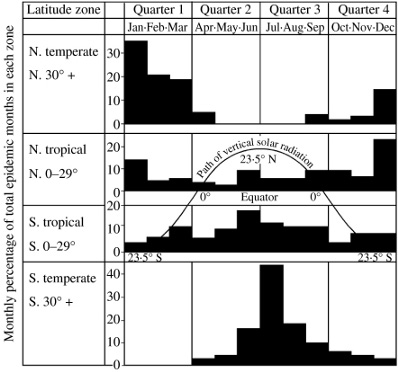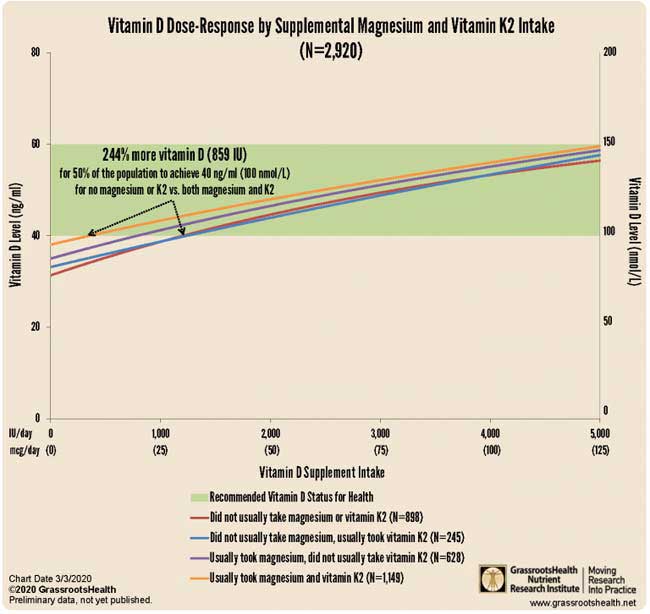This article was previously published December 11, 2020, and has been updated with new information.
As temperatures drop, rates of respiratory infections — the common cold and influenza, primarily — increase exponentially. Many believe this has to do with the drop in temperature, but cold exposure actually ramps up your immune system, making you less prone to infection.
According to a 2002 study1,2 by the U.S. and Canadian armies, cold exposure can double the number of natural killer (NK) cells in your body, which are part of your first line of defense against pathogenic infiltration and other types of cell damage.
As detailed by retired nurse and academic teacher John Campbell in the video above, a scientific review3 published in 2006 concluded that epidemic seasonal influenza is most likely related to the prevalence of vitamin D deficiency during winter months. According to the authors:4
“In 1981, R. Edgar Hope-Simpson proposed that a ‘seasonal stimulus’ intimately associated with solar radiation explained the remarkable seasonality of epidemic influenza.
Solar radiation triggers robust seasonal vitamin D production in the skin; vitamin D deficiency is common in the winter, and activated vitamin D, 1,25(OH)2D, a steroid hormone, has profound effects on human immunity.
1,25(OH)2D acts as an immune system modulator, preventing excessive expression of inflammatory cytokines and increasing the ‘oxidative burst’ potential of macrophages.
Perhaps most importantly, it dramatically stimulates the expression of potent anti-microbial peptides, which exist in neutrophils, monocytes, natural killer cells, and in epithelial cells lining the respiratory tract where they play a major role in protecting the lung from infection.”
 Source: Cannel et.al. 20065: Temperate latitudes show seasonal variation in viral infection rates that correspond to changes in solar irradiance. Tropical latitudes do not, because the solar variation is minimal.
Source: Cannel et.al. 20065: Temperate latitudes show seasonal variation in viral infection rates that correspond to changes in solar irradiance. Tropical latitudes do not, because the solar variation is minimal.
Inverse Relationship Between Flu Deaths and UVB Exposure
While vitamin D has been linked to many health benefits, the relationship between vitamin D and infectious disease is particularly robust. For example, a 2010 study6 by Norwegian researchers found there’s an inverse relationship between UVB sun exposure — which is how your body synthesizes vitamin D naturally — and influenza deaths. According to the authors:7
“Non-pandemic influenzas mostly occur in the winter season in temperate regions. UVB calculations show that at high latitudes very little, if any, vitamin D is produced in the skin during the winter.
Even at 26°N (Okinawa) there is about four times more UVB during the summer than during the winter. In tropical regions there are two minor peaks in vitamin D photosynthesis, and practically no seasonality of influenza.
Pandemics may start with a wave in an arbitrary season, while secondary waves often occur the following winter. Thus, it appears that a low vitamin D status may play a significant role in most influenzas The data support the hypothesis that high fluences of UVB radiation (vitamin D level), as occur in the summer, act in a protective manner with respect to influenza.”
Vitamin D Protects Against Fatal Lung Disease
Other studies8,9,10 have confirmed the long-held belief that vitamin D protects against tuberculosis, a fatal lung disease that kills an estimated 1.8 million people around the world each year.11 This is largely related to vitamin D stimulating antimicrobial peptides (AMPs) like cathelicidin (LL37).
In the past, tuberculosis was treated by making sure patients got plenty of sun exposure. In fact Finsen was given the Nobel Prize in 1903 for this determination. Around the turn of the 20th century regular sun exposure was the most effective clinical strategy for the treatment of tuberculosis, but was eventually phased out with the development of antibiotics.
A 2011 study in Science Translational Medicine examined the mechanisms responsible for your immune system’s ability to ward against tuberculosis, concluding that T cells play a central role. They release a protein called interferon-g, which in turn activates the release of AMPs so your immune cells can mount an effective attack against the tuberculosis bacteria.
However, in order for this activation to occur, you have to have sufficient levels of vitamin D. In patients with low vitamin D levels, this immune response was not activated. Meanwhile, among those with adequate levels, there was an 85% reduction of colony-forming tuberculosis bacteria. As reported by UCLA:12
“The team noted that vitamin D may help both innate and adaptive immunity, two systems that work synergistically together to fight infections. Previous research by the team found that vitamin D played a key role in the production of a molecule called cathelicidin, which helps the innate immune system kill the tuberculosis bacteria.
Humans are born with innate immunity, which is the preprogrammed part of the immune system. The current research findings demonstrate that vitamin D is also critical for the action of T cells, key players in adaptive immunity, a highly specialized system that humans acquire over time as they encounter different pathogens.”
More Than 80% of COVID Patients Are Vitamin D Deficient
Currently, the respiratory infection of note is of course COVID-19, and vitamin D appears to have a lot to do with your risk of this infection as well. According to a Spanish study13,14,15 published online October 27, 2020, in The Journal of Clinical Endocrinology & Metabolism, 82.2% of COVID-19 patients tested were found to be deficient in vitamin D. As reported by the authors:16
“In COVID-19 patients, mean± SD 25OHD levels were 13.8±7.2 ng/ml, compared to 20.9 ±7.4 ng/ml in controls. 25OHD values were lower in men than in women. Vitamin D deficiency was found in 82.2% of COVID-19 cases and 47.2% of population-based controls.
25OHD inversely correlate to serum ferritin and D-dimer levels. Vitamin D deficient COVID-19 patients had a greater prevalence of hypertension and cardiovascular diseases, raised serum ferritin and troponin levels, as well as a longer length of hospital stay than those with serum 25 OHD levels ≥ 20 ng/ml.”
While this particular study failed to find a correlation between vitamin D levels and disease severity, other studies have shown patients with higher levels do tend to have milder disease. In fact, one such study17,18 found your risk of developing a severe case of, and dying from, COVID-19 virtually disappears once your vitamin D level gets above 30 ng/mL (75 nmol/L).
SARS-CoV-2 positivity is strongly and inversely associated with circulating 25(OH)D levels, a relationship that persists across latitudes, races/ethnicities, both sexes, and age ranges. ~ PLOS ONE September 17, 2020
Other research19 looking at vitamin D and COVID-19 mortality found those with a vitamin D level between 21 ng/mL (50 nmol/L) and 29 ng/mL (75 nmol/L) had a 12.55 times higher risk of death than those with a level above 30 ng/mL. Having a level below 20 ng/mL was associated with a 19.12 times higher risk of death.
Vitamin D Lowers Your Risk of a Positive COVID-19 Test
Vitamin D has also been linked to a lower risk of testing positive for COVID-19. This, the largest observational study20 to date, looked at data for 191,779 American patients who were tested for SARS-CoV-2 between March and June 2020 and had had their vitamin D tested sometime in the preceding 12 months.
Of those with a vitamin D level below 20 ng/ml (deficiency), 12.5% tested positive for SARS-CoV-2, compared to 8.1% of those who had a vitamin D level between 30 and 34 ng/ml (adequacy) and 5.9% of those who had an optimal vitamin D level of 55 ng/ml or higher. As noted by the authors:21
“SARS-CoV-2 positivity is strongly and inversely associated with circulating 25(OH)D levels, a relationship that persists across latitudes, races/ethnicities, both sexes, and age ranges.”
How Vitamin D Impacts COVID-19
In June 2020, I launched an information campaign about vitamin D that included the release of a downloadable scientific report. This report, as well as a two-minute COVID risk quiz is available on StopCovidCold.com.
October 31, 2020, my review paper22 “Evidence Regarding Vitamin D and Risk of COVID-19 and Its Severity,” co-written with William Grant, Ph.D., and Dr. Carol Wagner, both of whom are part of the GrassrootsHealth expert vitamin D panel, was also published in the peer-reviewed journal Nutrients. You can read the paper for free on the journal’s website.
As noted in that paper, dark skin color, increased age, preexisting chronic conditions and vitamin D deficiency are all features of severe COVID disease, and of these, vitamin D deficiency is the only factor that is readily and easily modifiable.
You may be able to reverse chronic disease, but that typically takes time. Optimizing your vitamin D, on the other hand, can be achieved in just a few weeks, thereby significantly lowering your risk of severe COVID-19.
In our paper, we review several of the mechanisms by which vitamin D can reduce your risk of COVID-19 and other respiratory infections, including but not limited to the following:23
- Reducing the survival and replication of viruses24
- Reducing inflammatory cytokine production
- Maintaining endothelial integrity — Endothelial dysfunction contributes to vascular inflammation and impaired blood clotting, two hallmarks of severe COVID-19
- Increasing angiotensin-converting enzyme 2 (ACE2) concentrations, which prevents the virus from entering cells via the ACE2 receptor — ACE2 is downregulated by SARS-CoV-2 infection, and by increasing ACE2, you also avoid excessive accumulation of angiotensin II, a peptide hormone known to increase the severity of COVID-19
Vitamin D is also an important component of COVID-19 prevention and treatment for the fact that it:
- Boosts your overall immune function by modulating your innate and adaptive immune responses
- Reduces respiratory distress25
- Improves overall lung function
- Helps produce surfactants in your lungs that aid in fluid clearance26
- Lowers your risk of comorbidities associated with poor COVID-19 prognosis, including obesity,27 Type 2 diabetes,28 high blood pressure29 and heart disease30
Data from 14 observational studies — summarized in Table 1 of our paper31 — suggest that vitamin D blood levels are inversely correlated with the incidence and/or severity of COVID-19, and the evidence currently available generally satisfies Hill’s criteria for causality in a biological system.32
COVID-19 Features Related to Vitamin D Status
Our paper33 also details several features of COVID-19 that suggest vitamin D deficiency is at play. For starters, SARS-CoV-2 emerged in the winter in the northern hemisphere, and as we moved into summer, positive tests, hospitalizations and death rates fell. So, generally, COVID-19 prevalence has been inversely correlated with solar UVB doses and vitamin D production, just like seasonal influenza.
Secondly, people with darker skin have higher COVID-19 case and death rates than Caucasians. Vitamin D is produced in your skin in response to sun exposure, but the darker your skin, the more sun exposure you need in order to maintain an optimal vitamin D level. As a result, vitamin D deficiency tends to be far higher among Blacks and dark-skinned Hispanics.
Thirdly, one of the lethal hallmarks of COVID-19 is the cytokine storm that can develop in severe cases, which manifests as hyperinflammation and tissue damage. Vitamin D is known to regulate inflammatory cytokine production, thereby lowering this risk. Lastly, vitamin D is an important regulator of your immune system, and dysregulation of the immune system is a hallmark of severe COVID-19.
England to Hand Out Free Vitamin D Supplements
According to a November 28, 2020, BBC News report,34 British health officials are now recommending people take supplemental vitamin D this winter to reduce their risk of respiratory infections, including COVID-19.
Similar recommendations have been issued to the government health officials in Scotland, Wales and Northern Ireland. Unfortunately, no such recommendations have been issued in the U.S., which is why sharing this information is so important.
Senior care homes in the U.K. will receive enough vitamin D supplements to cover all residents, and people on the “clinically extremely vulnerable” list35 will have the option to get four months’ worth of free vitamin D supplements delivered to their homes starting in January 2021.
Even though the dose she recommended is 100% to 180% lower than the ideal range of 6,000 to 8,000 units per day, nevertheless chief nutritionist at Public Health England, Dr. Alison Tedstone, told the BBC:36
“We advise that everyone, particularly the elderly, those who don’t get outside and those with dark skin, take a vitamin D supplement containing 10 micrograms (400IU) every day. This year, the advice is more important than ever with more people spending more time inside, which is why the government will be helping the clinically extremely vulnerable to get vitamin D.”
Co-Nutrients Reduce Your Vitamin D Requirement
If you cannot get sufficient amounts of sun exposure to maintain a vitamin D blood level of 40 ng/mL (100 nmol/L) to 60 ng/mL (150 nmol/L), a vitamin D3 supplement is highly recommended. Just remember that the most important factor here is your blood level, not the dose, so before you start, get tested so you know your baseline. This will help you determine your ideal dose, as it can vary widely from person to person.
Also remember that you can minimize your vitamin D requirement by making sure you’re also getting enough magnesium. Magnesium is required for the conversion of vitamin D into its active form,37,38,39,40 and research41 has confirmed higher magnesium intake helps reduce your risk of vitamin D deficiency by activating more of it.
A scientific review42,43 published in 2018 concluded that up to half of all Americans taking vitamin D supplements may not get significant benefit as the vitamin D simply gets stored in its inactive form, and the reason for this is because their magnesium levels are too low.
Research by GrassrootsHealth reveals taking supplemental magnesium can lower your vitamin D need by 146%. Vitamin K2 is another important cofactor, and taking both magnesium and vitamin K2 can lower your vitamin D requirement by as much as 244%.44

Take-Home Message
All in all, the evidence is unmistakable: Optimizing your vitamin D can go a long way toward minimizing your chances of contracting a respiratory infection, be it the common cold, seasonal influenza or COVID-19.
Mounting evidence also demonstrates that if you do end up contracting COVID-19, having adequate vitamin D will lower the odds of you requiring hospitalization45 and intensive care46,47,48,49 as it reduces the severity of the infection.50,51 As detailed earlier, vitamin D also lowers your risk of dying from COVID-19.52,53,54,55,56
I urge everyone to share this information so that we can minimize additional outbreaks. Again, if you live in the northern hemisphere, now is the time to check your vitamin D level and start taking action to raise it if you’re below 40 ng/mL (100 nmol/L). Experts recommend a vitamin D level between 40 and 60 ng/mL (100 to 150 nmol/L).
An easy and cost-effective way of measuring your vitamin D level is to order GrassrootsHealth’s vitamin D testing kit. Also, if you haven’t already visited www.stopcovidcold.com please do so now so you can take your free COVID risk test and grab a free PDF copy of my vitamin D report, which has far better graphics than what we were able to put into our Nutrients paper.
Once you know your current vitamin D level, use the GrassrootsHealth vitamin D calculator57 to determine how much vitamin D you might need to reach your target level, and remember that increasing your magnesium and vitamin K2 intake will optimize your vitamin D absorption and utilization.
Retest your vitamin D level in three to four months to make sure you’ve reached your target level. If you have, then you’re taking the correct dosage. If you’re still low (or have reached a level above 80 ng/mL), you’ll need to adjust your dosage accordingly and retest again in another three to four months.

